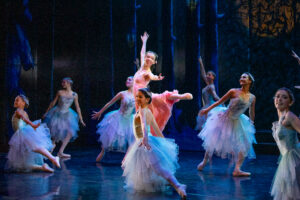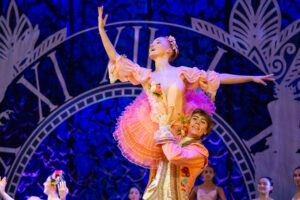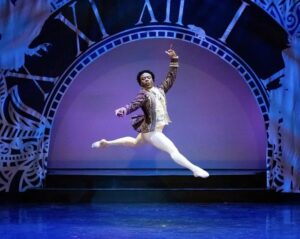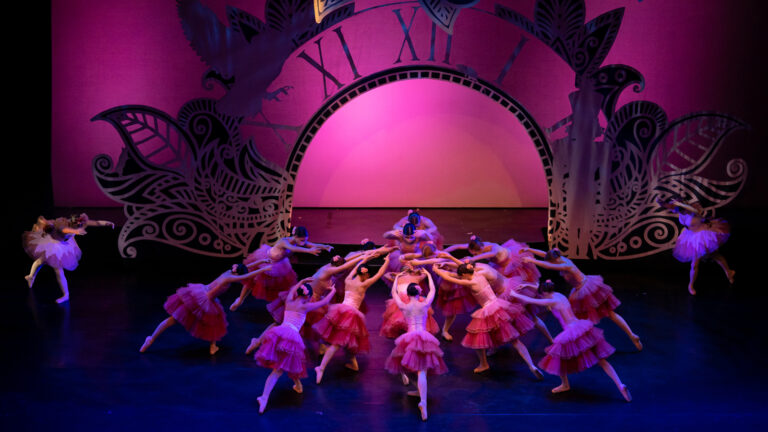As the holiday season approaches, the Nutcracker ballet takes center stage in Champaign Urbana. Illinois Public Media’s Kimberly Schofield and Owen Henderson sat down with Kay Greene, the Executive Director of the CU Ballet, and Kevin Burnside, a lead soloist, to talk about this year’s production. They discussed what goes into making this classic ballet a reality, from artistic choices to the practicalities of staging.
The CU Ballet is set to present The Nutcracker starting Thursday, November 30th at 7:30 pm, with performances running through Sunday, December 3rd, ending with a 6 pm show. The shows will take place at the Tryon Festival Theatre in the Krannert Center for the Performing Arts in Urbana. More information can be found on The Krannert Center’s website.

The following interview has been edited for clarity and length.
Owen Henderson: Kevin, I wanted to ask when you had first seen The Nutcracker and how you first started dancing.
Kevin Burnside: So I grew up pretty poor. I did not take any formal dance classes when I was a kid. I actually started when I was in high school, came to college as a dance major here at the university and I met Deanna Doty, who’s our artistic director, I think it was the end of my freshman year. I took ballet with her five days a week for the entire summer. And I would just get on the bus, come back to campus, and I would be limping and my legs would be tired. And it was like almost like, “why am I doing this, but oh my god, this is amazing” sort of energy. So I continued to dance at the university. I was on the dance team there, as well. Time passed, I opened the business, I had not danced in about 10 years. And I decided to take an adult class with Tracy McCabe, who is still one of our choreographers for the production. I got to the studio, saw Deanna, she looked at me and she goes, “Whoa, you are like a man now!” And this is my 12th season being back with everyone. It’s like a little family.
OH: You mentioned it’s your 12th Season doing this. And I believe this is the 26th year that CU Ballet has done The Nutcracker. I’ve heard people tell me “seeing The Nutcracker just kicks off the holiday season for me. I love going back to it every year.” And so they kind of have an expectation of what it is they’re going to see. But then you have performers who are coming back year after year. They might be changing roles, but they’re still in this show and hearing this music year after year after year. How do you balance keeping it the classic thing that everybody loves to go see versus keeping it interesting and fresh for the performers who are in the trenches, so to speak?
Kay Greene: So Deanna, her artistic brain is a beautiful thing, and she will come up with a different scene. So an example of that would be our Dutch Dairy scene. It used to be the scene with Mother Ginger and the Polichinelles. She actually took a tour of the Stone Ridge Dairy Farm here in Illinois, and we even had the dancers out there, and she fell in love. There’s pictures of her with these baby calves. That night, she called me and said, “Hey, I’m going to redo the Mother Ginger scene, I’m going to make it a Dutch Dairy.” So the Dutch Dairy was born. So we have a Dairy Queen and we have a barn and we have all these adorable little baby calves who come out of the barn and just delight the audience. So those are ways that she keeps it refreshing for the audience. And then as far as our cast members, they grow up on the stage. So they may start as a Dutch Dairy. And then they grow up and they become a mouse and then they become a soldier and then maybe they become a party boy or Fritz and then before you know it, they’re a herald and then they’re The Nutcracker and then they’re the Cavalier and they just keep going. It grabs a hold of them, the love of it, and they feel like they’re part of a family because I believe that we are a family. We care about each other and we support each other and encourage each other and they grow up with us.

Kimberly Schofield: Kevin, you kind of touched on this a little bit before, from your background growing up in a poor environment, not having dance experience…ballet can sometimes seem elitist. There’s kind of this stigma against ballet sometimes, whether it’s geared towards women or geared towards being a more white-based dance. How do you feel growing up with the Nutcracker, finding your space here in Champaign Urbana, and becoming a dancer? What’s that been like for you?
KB: I’m breathing because when you were asking the question, I just see all these faces of these people that come up to me after the show each year. So I’ll say that I feel blessed for the opportunity. I think that if Deanna hadn’t seen something in me and provided an opportunity for me, honestly, just because she’s who she is…it wasn’t…I didn’t give her anything. It just was…she saw that I wanted to do something and she wanted to support that. That continues even to this day. I will say that the biggest joy for me is having a mom or dad come up to me after the show and say, “My kid had never seen a black ballet dancer before and now they want to take ballet and it’s because they saw you on stage.” Or we had a dancer that was in the company…his mom told me that he came for the first rehearsal and then he wanted to leave, but I happened to be rehearsing in a studio and he saw me dancing and he said, “No, I want to stay. I want to be like him.” So little things like that…I can’t tell you how much they overwhelm me. It just makes me feel like representation matters. It seems like…of course, you can dance but if someone doesn’t see themselves in the people that are performing, it’s hard to cross that boundary. It’s a heavy burden that I carry and I carry it with privilege. And I just want everyone to feel like they have a place and everyone to realize that if they follow their dreams and their heart, they can do whatever they want.

OH: This is a show written by Tchaikovsky in the 1800s. Some criticisms have been leveled in recent years at the show writ large about the Chinese Tea Dance and the Arabian Coffee Dance, for example, of some companies leaning heavily on stereotypes when they put on those scenes. I was curious how you guys have been thinking about diversity and inclusion and not relying on those stereotypes when it comes to certain scenes of this ballet.
KB: From the traditional standard, Deanna takes artistic expression and makes it what she sees and makes it what feels like the most appropriate thing to do. We talk about the Chinese part…ours is a dragon. There’s a butterfly with the dragon. So it’s not really about trying to represent Chinese culture or Chinese people. It’s more so about just kind of giving a salute to things that may be looked at in the Chinese culture. Dragons are revered. If there’s a situation where someone’s like, “That offended me,” Deanna is very open-minded to making those changes in productions.
KG: Yeah, I think respect for every culture and for every person, for every dancer on the stage, for every audience member is the goal. We just want everyone to be entertained and be able to sit there for 45 minutes for act one and 45 minutes for act two and just shut it down for a minute. Just shut it down and relax and let them tell you this beautiful story. You don’t have to listen to any words or anything. It’s just watching this unfold on stage, the grace and athleticism of dancers like Kevin that make it look so easy and it’s so hard. And I think that’s our goal, you know, and the experience of… you get to come and get a cupcake for $1 and you’re supporting a special program, tickets for families, or you get to buy your annual Nutcracker at the boutique. It’s just joyful…
KB: And to be transformed. You know, we want people to come here and feel like they went to a magical place. The music, the costumes, the lighting, my God, there’s so much work behind the scenes that put the show on and everything is thought out. There’s a thoughtful approach to all of it, but we want people to come and just feel like they got their holiday season started with us.


